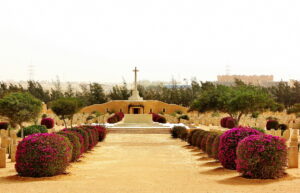El Alamein
“Before El Alamein, we never had a victory. After El Alamein we never had a defeat,” said Winston Churchill, during his Hinge of Fate speech.
El-Alamein, a small coastal outpost, is famous for the decisive victory doled out here by the Allies in WWII. The shadows of the conflict, in which over 80,000 soldiers were injured or died, are still present around here and in the surrounding battlefields. The translation of El-Alamein is “Two Worlds,” or “Two Flags,” a suitable name for the turning point of the North African campaign, which ultimately determined the fate of Egypt, and Britain’s Empire.
Tourists with an interest in the history of WWII should not miss a chance to visit such a key location.
The location itself is beautiful, with Churchill himself having said that this place enjoys the best climate in the world. The multiple shades of blue of the sea paired with the fine sands truly live up to this description. The Sidi Abd El Rahman beach resort overlooks the best bay on Egypt’s Mediterranean coast.
Today, El-Alamein is still occupied by Bedouin communities. Around a three-hour drive to the West of Cairo, there is an expanse which was named The Devil’s Garden. Here, the local Bedouins are still sometimes injured and killed by the approximately, 16 million land mines that are scattered around the expanse, rendering the battlefield itself too dangerous to explore.
The thousands of graves in the Commonwealth, German and Italian war cemeteries in the vicinity of the town are a bleak reminder of the losses on all sides, a [place of peace and tranquility for all of the those who visit.
What to see:
El-Alamein War Museum is a great introduction to the North African campaigns of WWII, including the Battle of El Alamein. It’s an intriguing collection of memorabilia, uniforms, and photos that leave us a personal reminder of the soldiers that fought here. Outside, a range of tanks, artillery, and hardware from the battle is displayed. “lest we forget”.
The haunting rows of 7,367 tombstones of The Commonwealth War Cemetery commemorate the deaths of soldiers from the UK, Australia, New Zealand, France, Greece, South Africa, East, and West Africa, Malaysia, and India who fought for the Allied cause. The 11,945 other souls whose bodies were never found are memorial cloisters, praising them for their bravery and courage.
At the end of an oleander-lined avenue is a white marble tower, The Italian War Memorial. It has a small museum and chapel dedicated to the 42,800 Italian soldiers, sailors, and airmen who died during the campaign.
A squat octagonal structure, modeled on the Castel del Monte in Apulia, is the German War Memorial. Its courtyard covers a mass grave of 4,280 soldiers, whose names are recorded on plaques beside stone sarcophagi, representing the soldiers’ home provinces.
The soldiers of Greece, Australia, and South Africa also have their own humble memorials.


